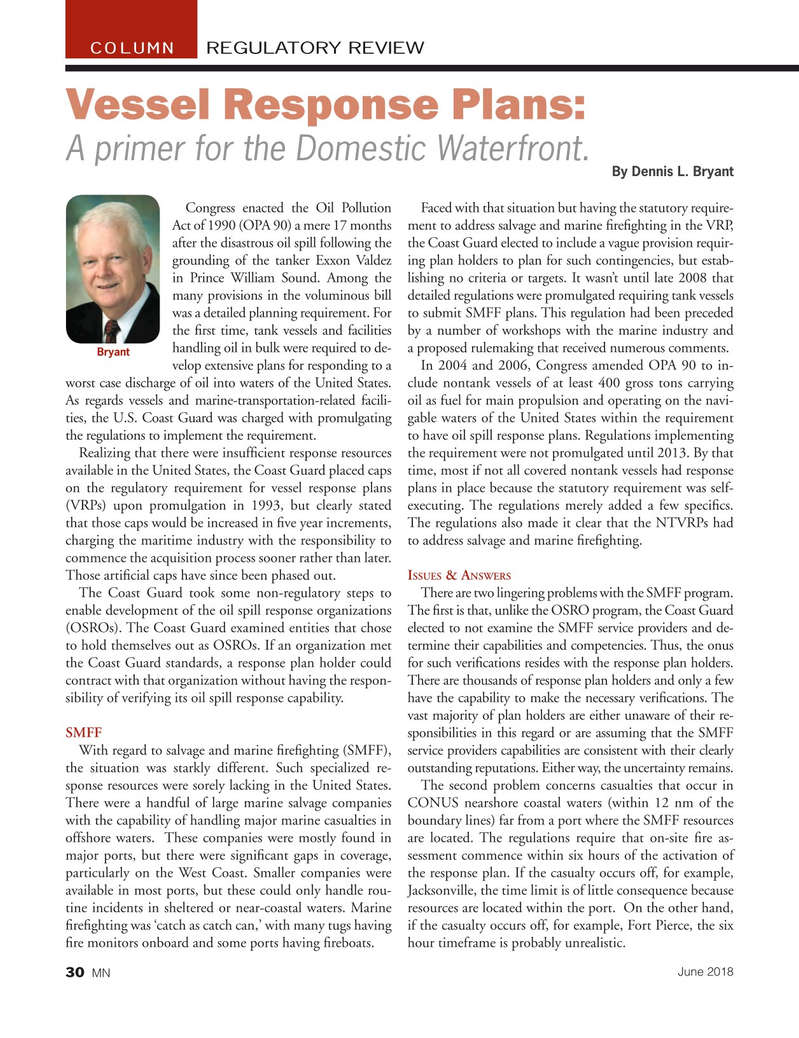
Page 30: of Marine News Magazine (June 2018)
Combat & Patrol Craft Annual
Read this page in Pdf, Flash or Html5 edition of June 2018 Marine News Magazine
COLUMN REGULATORY REVIEW
Vessel Response Plans:
A primer for the Domestic Waterfront.
By Dennis L. Bryant
Congress enacted the Oil Pollution Faced with that situation but having the statutory require-
Act of 1990 (OPA 90) a mere 17 months ment to address salvage and marine ? re? ghting in the VRP, after the disastrous oil spill following the the Coast Guard elected to include a vague provision requir- grounding of the tanker Exxon Valdez ing plan holders to plan for such contingencies, but estab- in Prince William Sound. Among the lishing no criteria or targets. It wasn’t until late 2008 that many provisions in the voluminous bill detailed regulations were promulgated requiring tank vessels was a detailed planning requirement. For to submit SMFF plans. This regulation had been preceded the ? rst time, tank vessels and facilities by a number of workshops with the marine industry and handling oil in bulk were required to de- a proposed rulemaking that received numerous comments.
Bryant velop extensive plans for responding to a In 2004 and 2006, Congress amended OPA 90 to in- worst case discharge of oil into waters of the United States. clude nontank vessels of at least 400 gross tons carrying
As regards vessels and marine-transportation-related facili- oil as fuel for main propulsion and operating on the navi- ties, the U.S. Coast Guard was charged with promulgating gable waters of the United States within the requirement the regulations to implement the requirement. to have oil spill response plans. Regulations implementing
Realizing that there were insuf? cient response resources the requirement were not promulgated until 2013. By that available in the United States, the Coast Guard placed caps time, most if not all covered nontank vessels had response on the regulatory requirement for vessel response plans plans in place because the statutory requirement was self- (VRPs) upon promulgation in 1993, but clearly stated executing. The regulations merely added a few speci? cs. that those caps would be increased in ? ve year increments, The regulations also made it clear that the NTVRPs had charging the maritime industry with the responsibility to to address salvage and marine ? re? ghting.
commence the acquisition process sooner rather than later.
SSUES NSWERS
Those arti? cial caps have since been phased out. I & A
The Coast Guard took some non-regulatory steps to There are two lingering problems with the SMFF program. enable development of the oil spill response organizations The ? rst is that, unlike the OSRO program, the Coast Guard (OSROs). The Coast Guard examined entities that chose elected to not examine the SMFF service providers and de- to hold themselves out as OSROs. If an organization met termine their capabilities and competencies. Thus, the onus the Coast Guard standards, a response plan holder could for such veri? cations resides with the response plan holders. contract with that organization without having the respon- There are thousands of response plan holders and only a few sibility of verifying its oil spill response capability. have the capability to make the necessary veri? cations. The vast majority of plan holders are either unaware of their re-
SMFF sponsibilities in this regard or are assuming that the SMFF
With regard to salvage and marine ? re? ghting (SMFF), service providers capabilities are consistent with their clearly the situation was starkly different. Such specialized re- outstanding reputations. Either way, the uncertainty remains.
sponse resources were sorely lacking in the United States. The second problem concerns casualties that occur in
There were a handful of large marine salvage companies CONUS nearshore coastal waters (within 12 nm of the with the capability of handling major marine casualties in boundary lines) far from a port where the SMFF resources offshore waters. These companies were mostly found in are located. The regulations require that on-site ? re as- major ports, but there were signi? cant gaps in coverage, sessment commence within six hours of the activation of particularly on the West Coast. Smaller companies were the response plan. If the casualty occurs off, for example, available in most ports, but these could only handle rou- Jacksonville, the time limit is of little consequence because tine incidents in sheltered or near-coastal waters. Marine resources are located within the port. On the other hand, ? re? ghting was ‘catch as catch can,’ with many tugs having if the casualty occurs off, for example, Fort Pierce, the six ? re monitors onboard and some ports having ? reboats. hour timeframe is probably unrealistic.
June 2018
MN 30
MN June18 Layout 18-31.indd 30 MN June18 Layout 18-31.indd 30 5/24/2018 2:20:35 PM5/24/2018 2:20:35 PM

 29
29

 31
31
